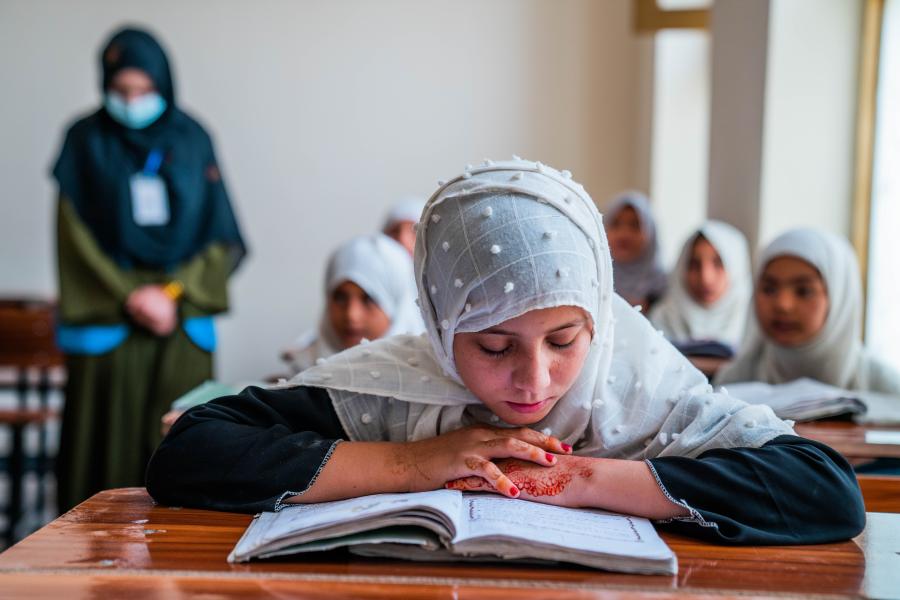2022 Year-end population figures
-
Refugees and asylum-seekers, including people in a refugee-like situation : 5.2 million, 23% women and 47% children
-
Internally Displaced People : 3.3 million, 21% women and 58% children
-
New Internally Displaced People in 2022 alone : 32,400, 57% children and 21% women
-
Internally Displaced returns : 236,200
2022 situation overview
Afghanistan was marked by devastating and multi-pronged challenges in 2022. The country struggled to cope with the aftershocks of the global pandemic, far-reaching impacts of the Ukraine crisis, a devastating earthquake, crippling food insecurity and deepening economic instability. The situation was further compounded by the destabilizing effects of the systematic erosion of women’s and girls’ rights and their gradual exclusion from public and political life by the de facto authorities, culminating in a ban on women working for NGOs, announced in December 2022. All this had a disproportionately negative impact on Afghan returnees, IDPs, refugees and asylum-seekers, as well as the communities that generously host them.
Since the end of the war in 2021, general access to deliver humanitarian assistance inside Afghanistan improved, and in 2022 UNHCR reached all 34 provinces and supported 6.2 million people. In line with UNHCR’s “Policy on cash-based interventions (2022–2026)”, UNHCR also expanded and integrated the use of cash assistance into various programmes to better support protection and solution outcomes.
1.5 million people received cash assistance, 4.1 million people benefited from various forms of community-based assistance, over 550,000 people received in-kind assistance, almost 360,000 core relief items were distributed and 60,000 people received psychosocial support. UNHCR also continued to invest in an area-based approach in the 80 Priority Areas of Return and Reintegration, aiming to build resilient communities, with a particular focus on health, education and livelihoods.
In Central Asia and the Islamic Republics of Iran and Pakistan, together hosting 8.2 million Afghans, including 2.6 million Afghans head-counted by the Government of the Islamic Republic of Iran in 2022, UNHCR and around 40 partners supported preparedness activities via the inter-agency Regional Response Plan (RRP), led and coordinated by UNHCR. Despite a challenging and complex funding landscape – only 52% of the RRP was funded by year-end – several gains were made. In the Islamic Republic of Iran, RRP partners contributed to the construction and rehabilitation of 54 schools (17 of which were newly constructed) and 15 health facilities while a further 185 health facilities were supported through in-kind and financial assistance.
By the end of 2022, RRP partners in the Islamic Republic of Pakistan supported some 2.2 million women, men and children – 80% of the people targeted – with one or more interventions and over half of those reached were women and girls. In Tajikistan, partnerships in the textile and IT sectors were expanded to facilitate livelihoods and skills development opportunities. This included job placements for some 330 refugees, vocational skills training for over 550 and start-up grants for close to 200.
A Pakistan Flood Response Plan was issued to shore up the humanitarian response to devastating floods, which affected some 33 million people, including an estimated 800,000 Afghan refugees residing in “calamity hit” districts.
In line with the Solutions Strategy for Afghan Refugees (SSAR) and the Global Compact on Refugees, UNHCR continued to support inclusive policies by channelling investment into national public service delivery systems and promoting collaborative policies and approaches via the SSAR Support Platform. Over 6,000 registered Afghan refugees voluntarily returned from the Islamic Republics of Iran and Pakistan and other countries to Afghanistan in 2022 – a significant increase from 2020 and 2021, although below the levels of previous years. Efforts to diversify partnerships were also stepped up, culminating in a strategic partnership with the World Bank at the regional level embedded under the SSAR. UNHCR and the World Bank brought together their unique expertise to form a Joint Strategic Analysis Hub for the Afghanistan situation, aiming to inform support for durable solutions to forced displacement in the Islamic Republics of Afghanistan, Iran and Pakistan, and Tajikistan and Uzbekistan.
Significant efforts were made to bolster existing coping mechanisms and build resilient communities able to withstand multiple shocks in 2022. This was intended to help mitigate further displacement – as well as onward movement – and support the foundation for eventual return and durable solutions. Resettlement and other complementary pathways, including education scholarships and labour mobility initiatives, increased although the availability of opportunities was far outweighed by the needs.
UNHCR submitted over 9,200 Afghans to 11 resettlement States in 2022. This included 6,600 individual submissions from the Islamic Republics of Iran and Pakistan – two countries which had low resettlement numbers in previous years. UNHCR recorded over 5,000 departures of Afghans on complementary pathways from host countries in Asia, primarily to Canada and Australia.
Central Asian countries continued to make progress in reducing and preventing statelessness, with Uzbekistan alone confirming the nationality of over 10,000 individuals in 2022. The statelessness situation in south-west Asia remained largely unchanged, although UNHCR monitored and provided policy advice on legislative developments in the Islamic Republic of Iran concerning women’s right to pass on their Iranian nationality to their children if the fathers are foreigners. Promoting universal birth registration and access to legal identity documentation, which addresses risk factors for statelessness – in line with Sustainable Development Goal Target 16.9 and the UN ESCAP Ministerial Declarations on Civil Registration and Vital Statistics – was also one of UNHCR’s core activities in the sub-region.
